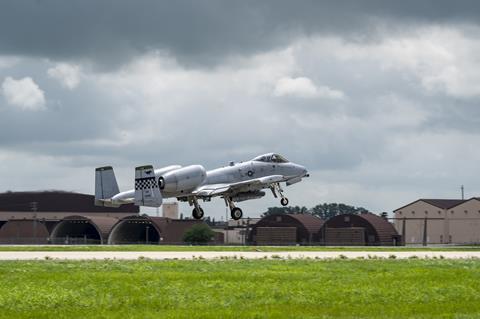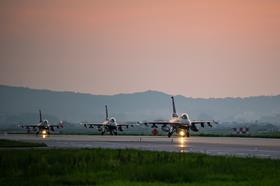Fighter aircraft from the USA and South Korea are wrapping up five days of military drills billed as the largest-ever exercise between the two countries.
Dubbed Ulchi Freedom Shield, the exercise over the Korean Peninsula includes a staggering 2,000 sorties during 120h of continuous flying from 19-23 August.
While Ulchi Freedom Shield is held annually, Seoul is describing this iteration as the “largest-ever” exercise undertaken between the Republic of Korea Air Force (ROKAF) and the US Air Force (USAF), which maintains two permanent air bases in South Korean territory.
“This is the first time that multiple air wings of the US Air Force will conduct 24h live-flight training to carry out multiple domain missions at the same time,” the ROKAF said on 20 August.
US Fairchild Republic A-10 attack jets based at Osan air base and Lockheed Martin F-16s from Kunsan air base joined the ROKAF’s own KF-16s, Boeing F-15Ks and Korea Aerospace Industries FA-50 light fighters for the marathon series of drills.
“Integration like this is what we’re here to do, to show everyone that we are ready to fight tonight when needed,” says USAF Colonel William McKibban, commander of the 51st Fighter Wing, which operates A-10s.
He adds that large exercises like Ulchi Freedom Shield are necessary to maintain readiness among the multinational fighter force in South Korea.

Despite the large show of force, Seoul describes the manoeuvres as defensive in nature, with the exercise missions including air interdiction, airborne alert interaction and counter-air sorties.
But aviators are also being evaluated on their ability to switch to offensive tactics.
“If an order is given to a combat mission aircraft that is conducting a defensive provision exercise, it will immediately switch to a combat patrol mission and carry it out,” the ROKAF notes.

Threats challenging American and South Korean pilots during the drills include infiltration of high-speed enemy aircraft, and cruise missile launches. While not explicitly named, the drills are presumably designed to counter the threat of a North Korean incursion across the heavily fortified demilitarised zone that separates the countries.
Lieutenant General Kim Hyung-so, head of the ROKAF Operations Command, says the goal of the massive fighter exercise is to ensure allied forces on the peninsula are ready to win “at any time, under any circumstances”.
The USAF is using slightly softer language, calling Ulchi Freedom Shield a set of “contingency response exercises” that will focus on practising mobilisation, force deployment and the protection and sustainment of base operations.
Military leaders and analysts in Washington have in recent years warned of risks facing large, well-established bases, should conflict erupt in the Indo-Pacific region. This month, top generals with the USAF declared they could no longer count on such facilities as being safe havens during a shooting war.
Countries like China and North Korea might target such facilities using their increasingly prolific stockpiles of long-range precision munitions.
Unclassified war games conducted by the US-based Center for Strategic and International Studies in 2022 found that Washington and allies could lose 900 aircraft during a conflict involving an attempt by China to take back Taiwan. Many of those losses would occur on the ground at major US facilities in East Asia, such as Kadena air base in Japan.
In addition to conventional defensive measures, the USAF is exploring a concept called Agile Combat Employment, which envisions using numerous smaller and more-austere ground sites to offset reliance on larger and vulnerable bases.


















































